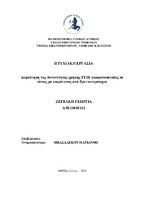| dc.contributor.advisor | Basalekou, Marianthi | |
| dc.contributor.author | Ζερβάκη, Γεωργία | |
| dc.date.accessioned | 2023-07-24T07:00:09Z | |
| dc.date.available | 2023-07-24T07:00:09Z | |
| dc.date.issued | 2023-07-10 | |
| dc.identifier.uri | https://polynoe.lib.uniwa.gr/xmlui/handle/11400/4807 | |
| dc.identifier.uri | http://dx.doi.org/10.26265/polynoe-4645 | |
| dc.description.abstract | Ο Brettanomyces bruxellensis αποτελεί έναν κοινό μολυσματικό παράγοντα στον οίνο και είναι
γνωστός για την ικανότητα του να πολλαπλασιάζεται και να παραμένει στα κελάρια παραγωγής. Η
παρουσία του δημιουργεί σημαντικές αλλαγές στο οργανοληπτικό προφίλ του οίνου. Ο μύκητας
παράγει ένα ευρύ φάσμα μεταβολιτών, όπου τα σημαντικότερα είναι το οξικό οξύ και οι
αιθυλφαινόλες με κύριες την 4-αιθυλφαινόλη και την 4-αιθυλγουαϊκόλη. Τα αρώματα του μύκητα
περιγράφονται ως ιδρώτας αλόγου, φαρμακευτικά, μυρωδιά αχυρώνα και ζωικό δέρμα. Οι
τρέχουσες μέθοδοι που διατίθενται για την μέτρηση της παρουσίας του μύκητα είναι χρονοβόρες
και δαπανηρές. Η φασματοσκοπία μετασχηματισμού Fourier αποτελεί μια γρήγορη και με μεγάλη
ακρίβεια μέθοδο η οποία εφαρμόζεται ολοένα και περισσότερο. Η παρούσα μελέτη διερεύνησε την
ταυτοποίηση αυξανόμενων συγκεντρώσεων του μύκητα σε ερυθρό οίνο και την κινητική του στην
πάροδο του χρόνου. Τα αποτελέσματα δείχνουν διαφοροποιήσεις στα φάσματα τόσο μεταξύ των
διαφορετικών συγκεντρώσεων μύκητα, που εμβολιάστηκαν, όσο και μεταξύ των διαφορετικών
ημερών. Έτσι φαίνεται καθιστάτε εφικτή η αξιοποίηση της τεχνικής αυτής στην ταυτοποίηση του
Brettanomyces bruxellensis σε ερυθρό οίνο. | el |
| dc.format.extent | 98 | el |
| dc.publisher | Πανεπιστήμιο Δυτικής Αττικής | el |
| dc.rights | Αναφορά Δημιουργού - Μη Εμπορική Χρήση - Παρόμοια Διανομή 4.0 Διεθνές | * |
| dc.rights | Attribution-NonCommercial-NoDerivatives 4.0 Διεθνές | * |
| dc.rights.uri | http://creativecommons.org/licenses/by-nc-nd/4.0/ | * |
| dc.subject | Βρεττανομύκητας | el |
| dc.subject | FTIR | el |
| dc.subject | Οίνος | el |
| dc.subject | Φασματοσκοπία υπερύθρου | el |
| dc.title | Διερεύνηση της δυνατότητας χρήσης FTIR φασματοσκοπίας σε οίνους με επιμόλυνση από Βρεττανομύκητα | el |
| dc.title.alternative | Feasibility of using FTIR in wines spoiled by Brettanomyces | el |
| dc.type | Πτυχιακή εργασία | el |
| dc.contributor.committee | Tataridis, Panagiotis | |
| dc.contributor.committee | Chatzilazarou, Arhontoula | |
| dc.contributor.faculty | Σχολή Επιστημών Τροφίμων | el |
| dc.contributor.department | Τμήμα Επιστημών Οίνου, Αμπέλου και Ποτών | el |
| dc.description.abstracttranslated | Βrettanomyces bruxellensis is a common wine yeast spoilage and is known for its ability to
multiply and persist in production cellars. Its presence creates significant changes in the
organoleptic profile of the wine. The yeast produces a wide range of metabolites, where the most
important are the acetic acid and the ethylphenols with the main ones being 4-ethyl phenol and 4-
ethyl guaicol. The aromas of Brettanomyces are described as horse sweat, medicinal, barn smell
and animal skin. Current methods available to measure the presence of Brettanomyces are time consuming and expensive. The Fourier Transform Infrared Spectroscopy is fast and highly accurate
method that is applied ever more. The present study investigated the identification of increasing
concentrations of Brett in red wine and its kinetics over time. The results show variations in the
spectra both between the different concentrations of Brett, that inoculated, and between the
different days. Thus, it seems possible to use this technique in the identification of Brettanomyces
bruxellensis in red wine. | el |


